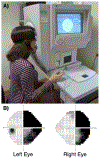Using Vision to Study Poststroke Recovery and Test Hypotheses About Neurorehabilitation
- PMID: 30744530
- PMCID: PMC6508080
- DOI: 10.1177/1545968319827569
Using Vision to Study Poststroke Recovery and Test Hypotheses About Neurorehabilitation
Abstract
Approximately one-third of stroke patients suffer visual field impairment as a result of their strokes. However, studies using the visual pathway as a paradigm for studying poststroke recovery are limited. In this article, we propose that the visual pathway has many features that make it an excellent model system for studying poststroke neuroplasticity and assessing the efficacy of therapeutic interventions. First, the functional anatomy of the visual pathway is well characterized, which makes it well suited for functional neuroimaging studies of poststroke recovery. Second, there are multiple highly standardized and clinically available diagnostic tools and outcome measures that can be used to assess visual function in stroke patients. Finally, as a sensory modality, the assessment of vision is arguably less likely to be affected by confounding factors such as functional compensation and patient motivation. Given these advantages, and the general similarities between poststroke visual field recovery and recovery in other functional domains, future neurorehabilitation studies should consider using the visual pathway to better understand the physiology of neurorecovery and test potential therapeutics.
Keywords: cortical blindness; hemianopia; rehabilitation research; stroke; stroke rehabilitation; vision disorders.
Conflict of interest statement
Conflict of Interest Statement:
The Authors declare that there is no conflict of interest.
Figures



Similar articles
-
Rehabilitation of cortically induced visual field loss.Curr Opin Neurol. 2021 Feb 1;34(1):67-74. doi: 10.1097/WCO.0000000000000884. Curr Opin Neurol. 2021. PMID: 33230035 Free PMC article. Review.
-
Digital therapeutics using virtual reality-based visual perceptual learning for visual field defects in stroke: A double-blind randomized trial.Brain Behav. 2024 May;14(5):e3525. doi: 10.1002/brb3.3525. Brain Behav. 2024. PMID: 38773793 Free PMC article. Clinical Trial.
-
Recovery from poststroke visual impairment: evidence from a clinical trials resource.Neurorehabil Neural Repair. 2013 Feb;27(2):133-41. doi: 10.1177/1545968312454683. Epub 2012 Sep 6. Neurorehabil Neural Repair. 2013. PMID: 22961263
-
International Practice in Care Provision for Post-stroke Visual Impairment.Strabismus. 2017 Sep;25(3):112-119. doi: 10.1080/09273972.2017.1349812. Epub 2017 Jul 31. Strabismus. 2017. PMID: 28759299
-
Adaptation to poststroke visual field loss: A systematic review.Brain Behav. 2018 Aug;8(8):e01041. doi: 10.1002/brb3.1041. Epub 2018 Jul 13. Brain Behav. 2018. PMID: 30004186 Free PMC article.
Cited by
-
Selective serotonin reuptake inhibitors for functional recovery after stroke: similarities with the critical period and the role of experience-dependent plasticity.J Neurol. 2021 Apr;268(4):1203-1209. doi: 10.1007/s00415-019-09480-0. Epub 2019 Jul 25. J Neurol. 2021. PMID: 31346698 Free PMC article. Review.
-
Persistent visual impairments following mild-to-moderate ischemic stroke.Front Ophthalmol (Lausanne). 2025 May 26;5:1505836. doi: 10.3389/fopht.2025.1505836. eCollection 2025. Front Ophthalmol (Lausanne). 2025. PMID: 40492149 Free PMC article.
References
-
- Winstein CJ, Stein J, Arena R, et al. AHA / ASA Guideline Guidelines for Adult Stroke Rehabilitation and Recovery.; 2016. - PubMed
-
- Winstein CJ, Stein J, Arena R, et al. Correction to: Guidelines for Adult Stroke Rehabilitation and Recovery: A Guideline for Healthcare Professionals From the American Heart Association/American Stroke Association. Stroke. 2017;48(2):e78–e78. - PubMed
Publication types
MeSH terms
Grants and funding
LinkOut - more resources
Full Text Sources
Medical

